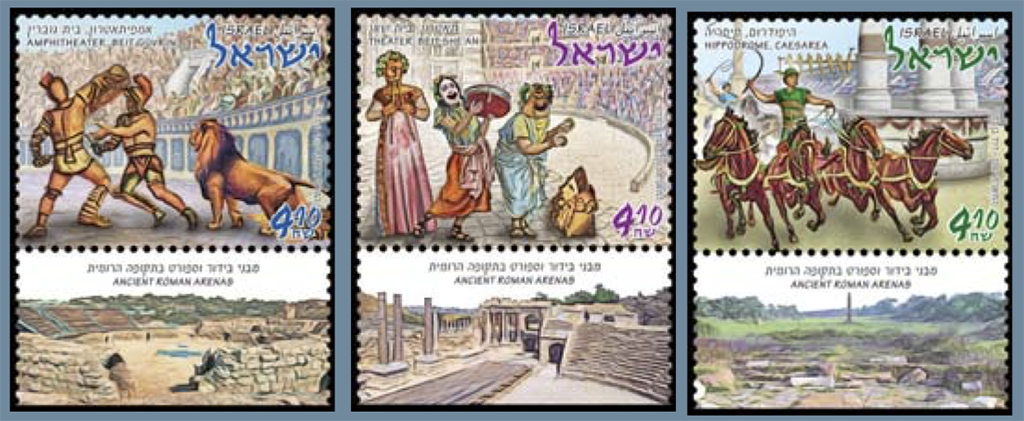From Israel Post. These stamps will be issued December 19, 2017.
Entertainment and sporting events constituted a significant part of the cultural activity in ancient Rome. The city rulers, who coined the phrase “bread and circuses”, distributed free food and built arenas as a way to placate the masses. Roman soldiers and officials brought their customs to every corner of the vast empire and contributed to the dissemination of this culture among local populations. Thus, these arenas became an important part of the urban landscape in Eretz Israel during the Roman Period.
The most common arena was the semi-circular Theater, in which all seats faced the front stage. Every self-respecting city built a theater and overall more than 30 theaters of varying sizes were constructed in Eretz Israel. The theater was adopted from the Greeks who preceded the Roman Period. Dramas, comedies and tragedies were performed in the Greek theaters, but the audiences’ tastes changed and in the Roman Period most of the performances were pantomimes and social satire. Rabbi Abbahu, an amora (Jewish Talmudist) and head of a yeshiva who lived in Caesarea in the 4th century described a satire performance in which actors dressed as animals took the stage as part of a show that mocked Jewish customs. The Jerusalem Talmud features a description of the role of an actor in a pantomime who hires the services of female musicians and dancers, applauds them, dances and plays the cymbals before them.
The elliptic Amphitheater, in which the audience sat around a central stage, was built outside the city. This venue hosted bloody performances, mostly featuring battles between gladiators or men versus animals. The Amphitheater also served as a venue for executions, as those sentenced to death were pitted against wild animals or were forced to fight for their lives in hopeless battles. These brutal shows were well liked by the Romans but not by local residents. Only a few Amphitheaters were discovered in Eretz Israel and these were built in cities where Roman troops were posted, such as Beit She’an, Caesarea and Beit Guvrin. The Jewish Sages, who generally forbade watching these bloody shows, allowed it in unusual circumstances “because shouting saves”: customarily, the audience was given the right to decide whether to kill the warrior who lost the battle, and Jewish spectators could lend their voices against the killing and possibly even save the life of a Jew fighting in the ring.
The Hippodrome (hippos = horse) was also built outside the city and mainly served as a venue for chariot races. The seats were placed along the long sides of the arena. One end had a curved wall and the other had a straight wall where the chariot gates were located. A grand divider decorated with statues and columns was erected in the center of the arena, between the two tracks. The chariots rode around this divider repeatedly during the race. The winning chariot driver got to hold a palm spoon and Sages equated the waving if the lulav during the Sukkoth festival to victory before God.
The Jewish Sages rejected the foreign culture brought to Eretz Israel by the Romans and considered it to be a complete contradiction to Jewish culture. “One may go to synagogues and places of Torah study or one may go to theaters and circuses” (Bereishit Rabbah 67:4). However, the Sages were well aware of what occurred at those entertainment venues and used this reality to illustrate their views to their followers.
Description of the Stamps and Sheet Margins
The illustrations on the stamps, the sheet margins and the cancellation were inspired by mosaics from the Roman Period and by 18th and 19th century works of art describing that period (books, paintings, posters).
Tab illustrations: based on photos by Moshe Rimer (Caesarea); Carole Raddato (Beit Guvrin); Israeltourism (Beit She’an).
Cover: adaptation of a photo by Israeltourism.



